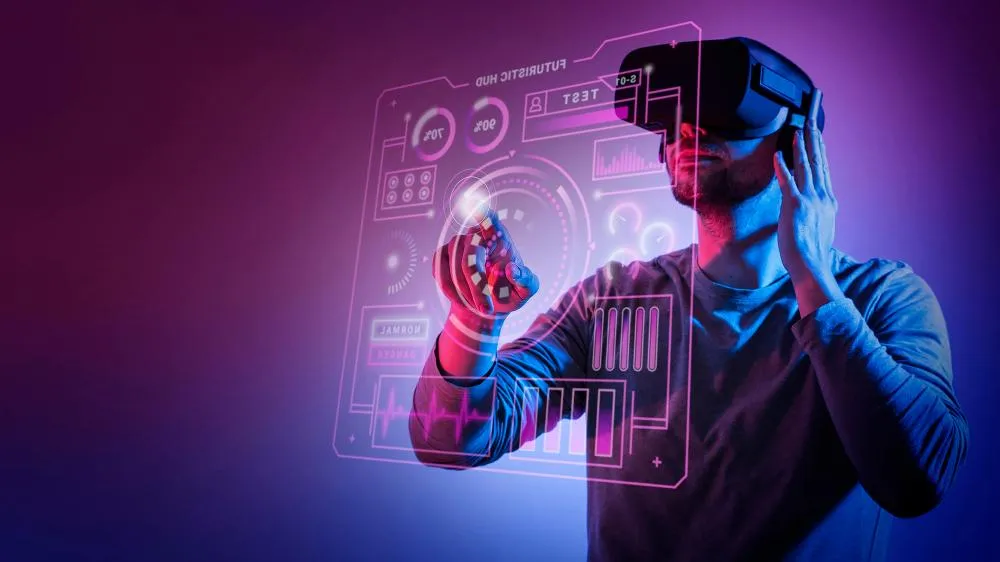BLOGS

Stepping Into New Realities: The Role of VR Labs in 21st Century Education
Introduction
In the ever-evolving landscape of education, keeping students engaged and making complex subjects accessible are among the paramount challenges faced by educators today.
Enter Virtual Reality (VR) Labs – an innovative solution that promises to revolutionize teaching and learning in Indian schools. As we delve deeper into the 21st century, the integration of VR technology in the classroom is not just an advancement; it's a necessity.
VR Labs offer an immersive learning experience that can transform abstract concepts into tangible realities, making education not only more engaging but also more effective.
The Immersive Power of VR in Education
Virtual Reality has the unique ability to transport users to different worlds, times, and situations. In the context of education, this means being able to explore the human body from the inside, travel through space and time to witness historical events, or dive deep into the ocean to study marine life firsthand. This level of immersion makes learning an active rather than passive experience, enhancing students' understanding and retention of complex subjects.
Making Complex Subjects Accessible and Engaging
One of the significant hurdles in teaching subjects like science, history, and mathematics is the abstract nature of their concepts. VR Labs can bridge this gap by providing a visual and interactive way to explore these subjects.
For instance, understanding the structure of DNA or the intricacies of the solar system becomes much more straightforward when students can see and interact with these elements in a three-dimensional space. This not only aids in grasping difficult concepts but also ignites a passion for learning among students.
Preparing Students for Future Challenges
The world our students will inherit is one where technology plays a central role. By integrating VR Labs into the curriculum, schools are not just enhancing the educational experience but also preparing students for future challenges.
VR technology fosters critical thinking, problem-solving skills, and adaptability – qualities that are invaluable in the rapidly changing job market. Furthermore, by exposing students to cutting-edge technology like VR, we're equipping them with the skills and confidence to navigate and innovate in a tech-driven future.
VR Labs: Beyond Just a Gadget
Integrating VR Labs into Indian schools goes beyond the allure of new technology. It represents a shift towards an education system that values experiential learning and understands the importance of adapting to technological advancements.
For school leaders, investing in VR technology is an investment in the future of education and their students. It's about creating an environment where learning is not just about memorizing facts but about understanding the world in a more profound, interactive way.
VR Labs in Schools
VR Labs in schools are dedicated spaces where students use Virtual Reality (VR) technology to enhance their learning experience. These labs integrate VR headsets and other equipment to provide immersive, interactive educational experiences that go beyond traditional teaching methods.
Key Features of VR Labs:
Immersive Learning Experiences: VR labs allow students to explore subjects like history, science, and geography through 3D simulations. For example, students can take virtual field trips to ancient civilizations, explore the human body, or walk on distant planets.
Interactive Simulations: VR labs offer interactive simulations where students can conduct experiments, solve problems, and engage in hands-on activities within a virtual environment. This approach helps in understanding complex concepts through visual and experiential learning.
Enhanced Engagement: The use of VR technology can make learning more engaging and exciting, capturing students' attention and fostering a deeper interest in the subject matter.
Collaboration and Communication: Many VR platforms support collaborative learning, allowing students to work together in a virtual space. This can enhance teamwork and communication skills.
Customized Learning: VR labs can be tailored to various educational needs and levels, providing personalized learning experiences based on individual student requirements.
Benefits:
Increased Engagement: VR can make abstract concepts more tangible and easier to understand.
Enhanced Retention: Immersive experiences often lead to better retention of information.
Real-World Applications: Students can experience real-world scenarios and applications of their studies in a controlled environment.
By incorporating VR labs into schools, educators can provide innovative and interactive learning opportunities that prepare students for a technology-driven future.
Conclusion
The role of VR Labs in 21st-century education extends far beyond mere novelty. It is about stepping into new realities where learning is immersive, engaging, and fun. As Indian K-12 school leaders, the opportunity to pioneer this transformational journey lies in your hands.
By embracing VR technology, you're not just adding an innovative tool to your educational arsenal; you're also opening up a world of possibilities for your students, preparing them for a future where they can not only adapt but thrive. The time to step into new realities is now, and it begins with a commitment to bring VR Labs into our classrooms, transforming the educational experience for the better.
FAQs
What are the benefits of VR labs in schools?
VR labs in schools enhance learning by providing immersive experiences that make abstract concepts more tangible. They improve student engagement, creativity, and understanding, especially in subjects like science, history, and geography.
How can schools implement a VR lab for students?
Schools can implement VR labs by investing in VR headsets, compatible software, and a dedicated space for virtual exploration. Partnerships with VR content providers and teacher training are also crucial for effective use.
What equipment is needed to set up a VR lab in schools?
A VR lab requires VR headsets, high-performance computers, hand controllers, VR-compatible software, and a spacious area for safe movement. Interactive displays or projectors can enhance the shared learning experience.
How do VR labs enhance STEM education in schools?
VR labs bring STEM concepts to life by simulating environments and experiments that would be too costly or dangerous to replicate in real life. This promotes better understanding, curiosity, and application of STEM principles.
What are the costs associated with setting up VR labs in schools?
The cost of setting up a VR lab can vary based on the equipment and software chosen, but typically ranges from 2,00,000 to 5,00,000. Schools may also need to budget for software licenses, technical support, and maintenance.
How can VR labs improve student engagement in schools?
VR labs provide immersive, hands-on learning experiences, allowing students to explore different worlds, perform virtual experiments, and engage interactively with content, leading to greater interest and retention in subjects.
Copyright 2024 Company. All rights reserved. Various trademarks held by their respective owners.





